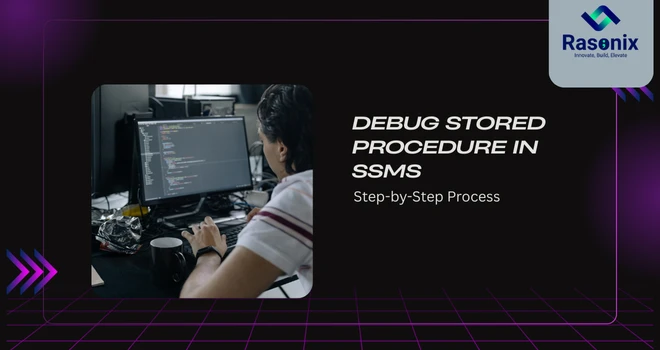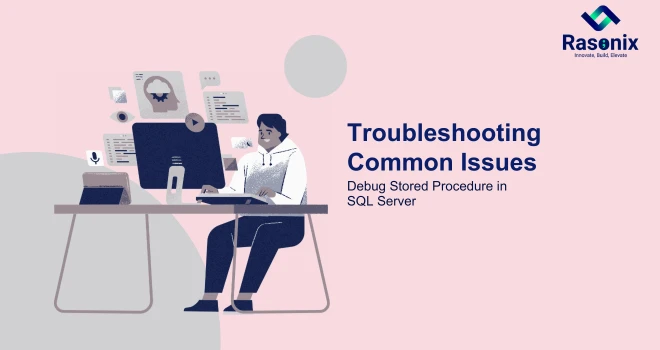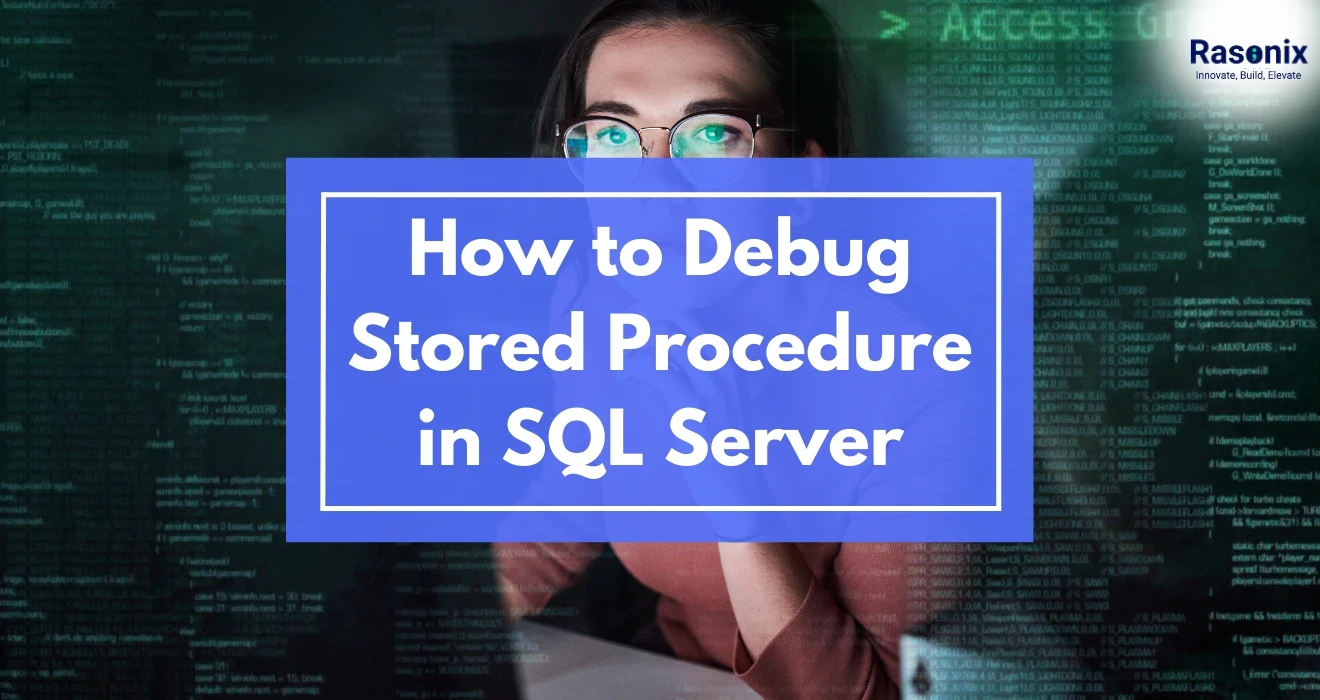The ability to debug stored procedure in SQL server is essential, mainly because stored procedures sometimes do not work as designed. Whether it's diagnosing a logical error or correcting incorrect data handling, debugging a stored procedure in SQL Server requires a combination of tools, instincts and lots of practice. This guide will assist in mastering the debugging of stored procedures using SSMS, Visual Studio and several other means.
Debug Stored Procedure in SQL Server with SSMS

Microsoft SQL Server Management Studio (SSMS) has an integrated debugger that allows developers to debug T-SQL code interactively. This functionality is no longer officially supported starting with version 18 and beyond, while it was available in earlier versions such as 2017. Developers can also now rely on code walkthroughs, tracking variables, and other external tools such as SQL Profiler instead of debuggers.
Supported Versions:
● SSMS 18 (SQL Server 2017–2019)
● SSMS 19 & 20 (SQL Server 2022 and later)
Debug Stored Procedure in SQL Server with SSMS 18, 19, 20, 2019, 2022
Step-by-Step Debugging in SSMS:
1. Open the Stored Procedure:
● Link to your SQL Server model in SSMS.
● Navigate to the stored procedure under Programmability > Stored Procedures.
● Right-click the procedure and choose Modify.
2. Enable Debugging:
● In SSMS 17 or earlier, use the menu: Debug > Start Debugging or press Alt + F5.
● In SSMS 18 and later, manual debugging involves adding PRINT, RAISERROR, or using external tools.
3. Set Breakpoints:
● Clicking in the narrow column to the left of the code will insert a breakpoint indicator.
● Use F9 to toggle breakpoints.
4. Run the Procedure with Parameters:
● Set input parameters using a test script.
● Example:
● DECLARE @OrderID INT = 10248;
● EXEC usp_GetOrderDetails @OrderID;
5. Step Through the Code:
● Press F11 to Step Into, F10 to Step Over, and Shift + F11 to Step Out.
Setting and Managing Breakpoints
By setting basic breakpoints, you can interrupt the procedure's execution at particular lines of code.
IF @TotalAmount > 1000
SET @Discount = 0.1;
Conditional Breakpoints:
-- Right-click breakpoint → Conditions
-- Condition: @CustomerType = 'VIP'
IF @CustomerID = 'ALFKI'
BREAK;
Hit Count Breakpoints:
Useful inside loops to trigger on specific iterations.
Also, Checkout: Understanding .NET Framework in C#: Architecture, Features, & Applications
Inspecting Variable Values
● Local Window: In the Locals window, you can view every declared variable and its corresponding current value.
● Watch Window:
- Add specific variables to monitor.
- Useful for observing value changes during execution.
● QuickWatch:
- Highlight a variable, right-click > QuickWatch.
- View real-time value changes.
Stepping Through Code Execution
Action Shortcut Purpose
Step Into F11 Dive into procedure/function calls
Step Over F10 Execute line without entering sub-procedures
Step Out Shift + F11 Exit current procedure
Advanced Debugging: Visual Studio + SQL Server

Visual Studio provides a more modern and integrated debugging environment for SQL Server developers.
Steps to Debug:
1. Connect to SQL Server
● View → SQL Server Object Explorer → Connect.
2. Open Stored Procedure
● Navigate to Databases → Programmability → Stored Procedures → Right-click → View Code.
3. Set Breakpoints & Start Debugging
● F9 to set breakpoints, then Debug → Start Debugging.
Why Use Visual Studio for Debugging?
1. Cleaner UI
2. Deeper call stack tracing
3. Smooth integration with source control
4. Supports T-SQL unit testing
Troubleshooting Common Issues

Scenario 1: Incorrect Data Updates
Problem: Data updates aren’t reflecting as expected.
Steps to Debug:
● Set breakpoints before the UPDATE statement.
● Check variables in Locals.
● Query updated table after execution.
Code Example:
UPDATE Orders SET OrderDate = @IncorrectDate
WHERE CustomerID = @CustomerID;
Fix: Validate the value of @IncorrectDate. Log its value before execution.
Scenario 2: Unexpected Control Flow
Problem: Conditional branches are not executing correctly.
Steps to Debug:
● Break inside each IF/ELSE block.
● Inspect condition variables.
Code Example:
IF @Status = 'Pending'
BEGIN
UPDATE Orders SET ProcessingDate = GETDATE();
END
Fix: Check the actual value of @Status. Watch out for casing spaces.
Scenario 3: Errors in Loops
Problem: Loop behaves unexpectedly or crashes.
Steps to Debug:
● Breakpoint inside the loop.
● Use hit count breakpoints to check specific iterations.
Code Example:
DECLARE @Counter INT = 1;
WHILE @Counter <= @MaxCount
BEGIN
INSERT INTO LogTable (Value) VALUES (@Counter / (@Counter - 1));
SET @Counter = @Counter + 1;
END
Fix: Prevent divide-by-zero. Add guards or TRY...CATCH.
Scenario 4: Issues with Temporary Tables
Problem: Temp tables/table variables return no data.
Steps to Debug:
● Break after INSERT.
● Check contents using SELECT * FROM #TempTable.
Code Example:
CREATE TABLE #TempOrders (OrderID INT, Total DECIMAL(10,2));
INSERT INTO #TempOrders
SELECT OrderID, SUM(Amount) FROM OrderDetails GROUP BY OrderID;
SELECT * FROM #TempOrders WHERE Total > @Threshold;
Fix: Validate the aggregated data and @Threshold logic.
Scenario 5: Performance Bottlenecks
Problem: The procedure runs slow.
Steps to Debug:
● Identify large loops and slow queries.
● Analyze execution plan (outside debugger).
● Use SQL Profiler or Extended Events.
Code Example:
WHILE EXISTS (SELECT 1 FROM Orders WHERE Processed = 0)
BEGIN
-- processing logic
END
Fix: Add proper indexes. Replace loops with set-based operations.
How to Trace a Stored Procedure in SQL Server
Using PRINT or RAISERROR
PRINT 'Reached before IF block';
RAISERROR ('Check @OrderID: %d', 10, 1, @OrderID) WITH NOWAIT;
SQL Server Profiler
● Create a new trace.
● Filter on ObjectName or LoginName.
● Observe RPC:Completed and SP:StmtCompleted events.
Extended Events
● More lightweight alternative to Profiler.
● Set up a session to track procedure execution, exceptions, CPU time.
Best Practices for Debugging & Development
Modular Design
● Break large procedures into smaller ones.
● Easier to test, debug, and reuse.
Error Handling
● Use TRY...CATCH blocks:
BEGIN TRY
-- code
END TRY
BEGIN CATCH
PRINT ERROR_MESSAGE();
END CATCH
Logging and Auditing
● Create a logging table.
● Log key steps, parameters, and errors.
Unit Testing
● Write scripts to validate each part of the logic.
● Use expected input-output pairs.
Use Source Control
● Track every version.
● Roll back bugs easily.
Perform Code Reviews
● Spot bugs early.
● Share debugging ideas and patterns.
Conclusion:
To debug stored procedure in SQL Server requires more than just knowledge of the interface; you need to have a thorough understanding of the intended behaviour of your code, a logical process for determining when that behaviour is not happening, and the ability to fix code without producing additional, unintended behavior. Whether you are more comfortable with the familiar SSMS or the full integration of Visual Studio, effective debugging is grounded in process, careful investigation, and knowing when to use the right tools.
After reading and practicing the techniques as well as relying on the applicable strategies outlined in this document, you should find yourself becoming better prepared to debug stored procedure in SQL Server effectively—isolating defects quickly, applying targeted fixes, and ideally reducing the risk of critical issues arising in production. The core of code that is clean and reliable is intelligent debugging. When debugging stored procedures, it’s equally important to know how to run PL/SQL program step by step for smooth testing.
At the same time, we all understand that what actually happens can be messy. You might have a procedure that reduces application performance with no apparent reason or be stuck in a loop which never provides the exit condition. It's during these challenging times when external help often provides experience that can be vital especially when you need to debug stored procedure in SQL Server fast and with minimal disruption.
Need a Hand with SQL Server?
At Rasonix, we partner with any and all businesses to sift through stored procedures, diagnose real-time problems, and increase performance on SQL Server. If you’re done chasing down elusive bugs, or just want to know why your queries are failing or running poorly, we can help.
Hire an experienced SQL Developer
1. Get hands-on help to fix sluggish or broken procedures
2. Refactor legacy code without breaking what already works
3. Speed up performance and cut database downtime
4. Work with seasoned SQL professionals who have seen it all
Ready for us to put this to bed once and for all? Reach out to us at Rasonix and we can make your SQL code run like it was meant to run.
Frequently Asked Questions:
How can we debug a procedure in SQL development?
SQL Developer is built for Oracle databases. Use Oracle’s DBMS_DEBUG or PL/SQL debugger, it debugs SQL procedures from an Oracle database from SQL Developer.
How can we debug SQL queries in an SQL server?
Use PRINT, RAISERROR, or SSMS messages. You can also look at the row counts and output which usually gives clues to the cause of the problem. You may also check the pre/post values of any variables you have defined to provide further assistance.
How can we debug stored procedures in VS code?
You may consider using SQL Server extensions such as mssql. There is limited support for step debugging, but it is a great tool for writing and testing SQL, application debugging, or logging.
How can we debug stored procedures in MySQL?
MySQL Workbench has a visual debugger that provides debugging functionality. You may also add SELECT, SIGNAL, or SET for tracing logic manually.





















 Subscribe Now
Subscribe Now